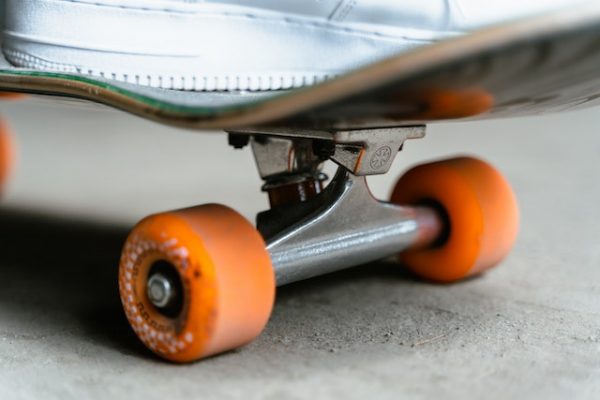Skateboarding, with its thrilling maneuvers and boundless creativity, has long captivated the hearts of adventurers and free spirits. For those seeking an even deeper connection with skateboards, wanting to build your very own skateboard from scratch unlocks a realm of possibilities for you to have self-expression and crafting experiences. Making your skateboard is a good form of art.

Key Takeaways
- Assembling your skateboard allows for a personalized and unique skateboarding experience.
- The process of crafting your skateboard involves selecting the right deck, grip tape application, installing trucks, and adding wheels, bearings, and other hardware.
- Customizing your skateboard enables you to express your style, personality, and preferences.
- Safety should be a top priority, and riders should always wear appropriate safety hardware gear.
- Regular maintenance is crucial to ensuring your skateboard’s optimal performance and longevity.
- The art of crafting extends beyond crafting, becoming a reflection of the skater’s creativity and spirit.
- Your crafted complete skateboards become a medium of self-discovery and a tool for unfettered expression on the road or at the skatepark.
What About Making Your Skateboard?
Assembling your own complete skateboards can be a rewarding and creative way to experience. It allows you to customize your skateboarding experience to suit your style and your preferences. To help you get started, here’s a comprehensive guide on how to build a complete set of custom skateboards on your own:
Skateboard Materials
Before you begin a build a skateboard, make sure you have all the essential skateboarding tools and skateboarding materials at hand. You’ll need:
- Skateboard deck: The wooden board that forms the main body of the board.
- Grip tape: The rough, sandpaper-like material that covers the deck’s top for traction.
- Trucks: Metal T-shaped components that attach to the deck and hold the wheels.
- Wheels: Choose wheels of the appropriate size and hardness for your riding style.
- Bearings: Small metal balls that fit inside the wheels to reduce friction.
- Hardware: Bolts and nuts to secure the trucks to the deck.
- Skateboard tool: A multi-tool designed specifically for board assembly.
- Razor blade: This is used to cut the grip tape.
- Screwdriver: This is used to adjust the trucks and attach skateboard hardware.
- Safety equipment: Always wear appropriate safety gear, including a helmet, knee and elbow pads, and shirts.
Selecting The Right Skateboard Deck

Build your own skateboard deck that suits your skateboarding style, body size, and skill level. Skateboard decks come in various shapes, sizes, and materials. The width is measured in inches, typically ranging from 7.5″ to 8.5″ or more.
Applying Skateboard Grip Tape
Carefully peel off the backing of the grip tape and apply it to the top of your new skateboard deck. After ensuring a smooth application, build a skate like a pro. Smooth out any air bubbles until you’re content, and trim the excess grip tape using a razor blade or box cutter. Use the skateboard tool to file down the edges of the grip tape for a clean finish. Remember, the quality of the grip tape can impact the price and performance of your skateboard so don’t skip this process.
Installing Skateboard Trucks
Use the provided skateboard hardware to attach the trucks to the wider skateboard deck. Make sure the kingpin (the large bolt on the truck) faces toward the center of your skateboard.
Adding Skateboard Wheels And Bearings
Insert the bearings into the skateboard wheels (usually two per wheel). Place the skateboard wheels onto the trucks’ axles and secure them with bolts and nuts. Tighten the nuts enough to hold the skateboard wheels, bearings, and hardware in place but not so much that they can’t spin freely.

Fine-Tuning The Setup
Adjust the tightness of the skateboard trucks according to your own preferences. Looser trucks offer more maneuverability, while tighter skateboard trucks provide stability. If you’re unsure about the right settings, visiting a skate shop can be helpful, especially if you aim to build your own skateboard from scratch. The skateboard builder there can give expert advice and even provide the necessary skateboard hardware. Make sure to punch holes correctly for the best fit. Experiment to find the setup that returns and works best for you.
Skateboard Safety Check
Before hitting the road or skating park, double-check all pro skateboard components to ensure they are securely fastened. Tighten any loose wheel nuts or bolts.
Skateboard Maintenance And Care
Regularly inspect your skateboard for signs of wear and tear. Replace worn-out skateboard components, such as wheels, bearings, and grip tape, to maintain optimal performance and skateboarding safety. Using a skate tool can aid in the inspection and adjustments, especially when tuning up for street skating. Ensure the grip tape is secured properly to the top of the skateboard deck for a good grip.
It is fun to build a skateboard. If you’re uncertain about certain parts or their fitting, visiting your local skate shop can offer guidance. Always ensure you build your own skateboard correctly, but it’s essential to prioritize skateboarding safety and ensure all skateboard components are securely built before riding. Happy skating!
Conclusion
Frequently Asked Questions (FAQs)
Last Updated on July 6, 2024 by Jeanne Meets
DISCLAIMER (IMPORTANT): This information (including all text, images, audio, or other formats on FamilyHype.com) is not intended to be a substitute for informed professional advice, diagnosis, endorsement or treatment. You should not take any action or avoid taking action without consulting a qualified professional. Always seek the advice of your physician or other qualified health provider with any questions about medical conditions. Do not disregard professional medical advice or delay seeking advice or treatment because of something you have read here a FamilyHype.com.